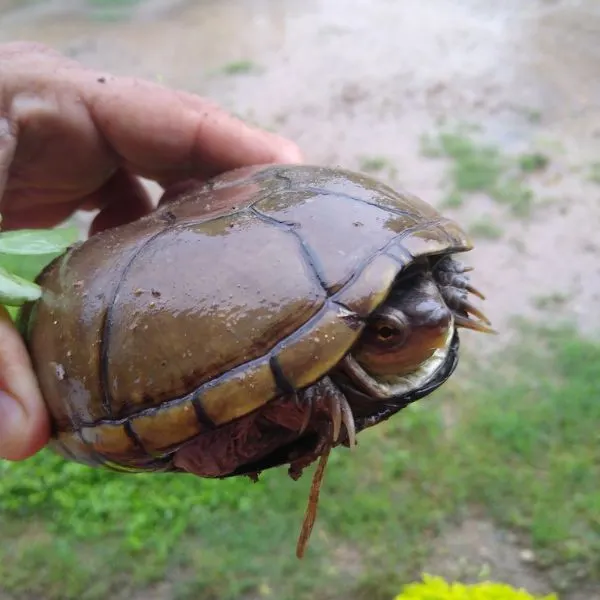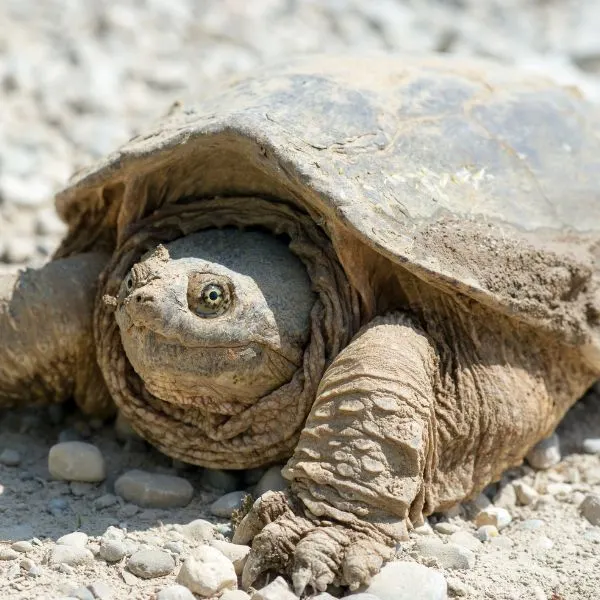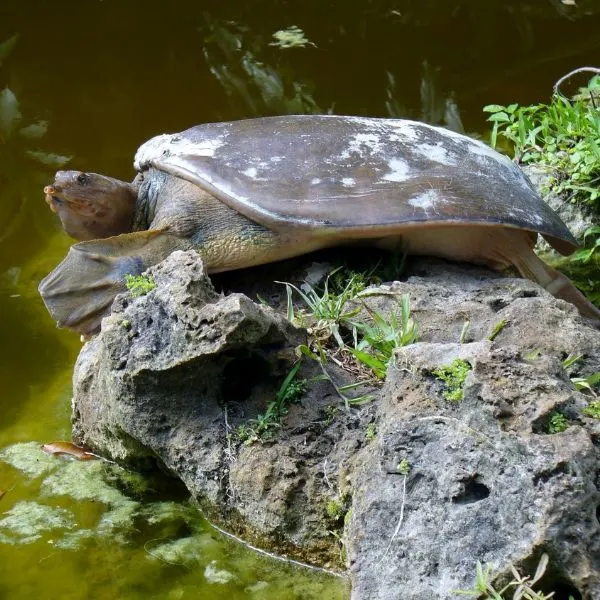There are 5 Types of turtles in Colorado. The State is home to incredible wildlife including bison, black bears, mountain lions, moose, elk, and the state animal, the bighorn sheep.
The Rocky Mountain state has 42 state wildlife parks, so wildlife is a big part of this area. Among the towering mountains and very large animals, you’ll also find 5 species of turtles.
Often the turtle is an overlooked animal within the United States, however, Canada and the United States host around 57 different species of turtles – which is more than any other country in the world.
As mentioned above there are 5 species in particular that are native to the Centennial State. Four of those five species are aquatic, and one is a terrestrial species, the Ornate Box turtle.
Table of Contents
Types Of Turtles in Colorado
1. Yellow Mud Turtle

- Experience level: Intermediate
- Family: Kinosternidae
- Scientific Name: Kinosternon flavescens
- Common Name: Mud Turtle, Yellow Mud Turtle
- Average Adult Size: 5 – 7 inches
- Life Span: 40 years
- Average Price Range: Approximately $80 to $300
- Conservation Status: Greatest concern in Colorado
You may only find Yellow Mud Turtles in the far south-eastern counties of the state, though they can be found as far south as Mexico. These small turtles prefer wetlands and water that has muddy bottoms, but sandy ridges, or banks. They need the sand to lay eggs and burrow during hot summers and cold winters.
Though named yellow, their upper shells (carapace) are usually olive colored but can be lighter, and typically have dark outlines along the scutes. They do have yellow along their throats and along the outer ridge of their shell and the bottom (plastron).
Yellow Mud turtles have large heads in relation to the rest of their body. Their limbs are darker colored on the outer edge and lighter colored—yellow, cream, or sand—on the inner side. Their carapace is highly domed, but flat along the top.
Though not named a musk turtle, they can emit a foul smelling musk from glands if they are disturbed or feel threatened.
Though an aquatic species, they will often leave the water in search of food or another habitat. They eat a mostly carnivorous diet including worms, crayfish, mollusks, fish, tadpoles, and insects. The Yellow Mud turtle will also eat duckweed on occasion.
2. Common Snapping Turtle

- Experience level: Intermediate to Expert
- Family: Chelydrida
- Scientific Name: Chelydra Serpentina
- Common Name: Common Snapping Turtle, Snapper, Eastern Snapping Turtle
- Average Adult Size: 8 to 20 inches
- Life Span: 30 – 50 years
- Average Price Range: Approximately $40 to $120
- Conservation Status: Least concern
The Common Snapping Turtle is thought of as an aggressive turtle because everyone has seen pictures and videos of them hissing and snapping at anything stuck in front of their faces. Well, if I was rudely yanked out of my house, had a ton of cameras pointed in my eyes, and then someone stuck their hand in my face I’d probably curse them out and bite too!
Like most animals, the Common Snapping turtle just wants to be left alone. In fact, they aren’t terribly aggressive as long as they are left alone. In the water, Snapping turtles will hide or swim away from trouble, not confront it head on.
Outside of the water, they are only trying to defend themselves because they are big, bulky, and don’t feel comfortable out of the water. These big turtles often bask by swimming near the surface of the water. They rarely come out of the water.
One thing that can bring a snapping turtle out of the water is when a female is trying to find a suitable place to nest and lay her eggs. So, if you see a Snapping turtle out of the water, don’t put her back in, just leave it alone and let it go where it wants.
If a Snapping turtle does bite, it can cause deep lacerations because they have strong jaws and a sharp beak. Their head can strike out like a snake, and they have a long reach.
Snapping turtles range from brown, dark green to black. Their shells are thick but don’t completely cover them. They have thick limbs, long claws, and very long tails for turtles.
Snapping turtles can live in most types of freshwater, and can even stand some brackish water terrains. Most of their time is spent at the bottom waiting for morsels of food to swim by. When something edible gets close, they instantly snap it up.
They enjoy a more carnivorous diet. They will feed on fish, crayfish, amphibians, and even smaller turtles. When meat is hard to find, snapping turtles will feed on vegetation.
Interestingly, the Common Snapping turtle has been recognized as the state reptile of New York since 2006.
3. Western Painted Turtle

- Experience Level: Beginner
- Family: Emydidae
- Scientific Name: Chrysemys Picta Belli
- Other Names: N/A
- Adult Size: Between 4 and 10 inches
- Lifespan: Between 30 and 50 years
- Average Price Range: Between $30 and $150
- Conservation Status: Least concern
The Western Painted Turtle is a subspecies of the Painted Turtle. They look like they’ve been painted and have olive to black skin with stripes of red, yellow, or orange along their bodies. They are a smaller turtle compared to some other species.
The Western Painted turtle has a smooth carapace that’s usually solid colored in dark green or black. The plastron on this species of painted turtle is red with darker, or black colored patterns.
A highly aquatic turtle, they rarely leave the water except to bask on logs, rocks, or the banks of their habitat. Often they will sleep on the bottom of their watery home. In colder climates, these turtles will brumate in the water and become more active during mild winter days.
Painted turtles are the most common turtle in the United States, and the Western species is Colorado’s most prolific turtle. They can be found in rivers, lakes, ponds, roadside pools, and pasture ponds.
Western Painted turtles are omnivorous. They will eat insects, larvae, mollusks, fish, carrion, and vegetation. If it’s remotely edible, the painted turtle will probably eat it.
4. Ornate Box Turtle

- Experience Level: Intermediate to Expert
- Family: Emydidae
- Scientific Name: Terrapine ornata
- Other Names: Box Tortoise, Western Box Turtle
- Adult Size: 4 to 5 inches (10 to 12.5 cm)
- Lifespan: 30 to 40 years
- Average Price Range: $150 to $450
- Conservation Status: Near Threatened
The Ornate Box Turtle’s name is derived from their protection mechanism where they draw their heads and legs into their shell and appears like a box. This is because they have a hinged plastron and can completely enclose themselves in their little shells.
The Ornate Box turtle has a dark colored domed shell with yellow markings on each scute. These markings generally look like spots or stripes.
Their skin is dark green with yellow spots or blotches. Females are bigger, and their shells are typically brown with yellow stripes.
Over the years their habitat has been reduced and they are continually being caught in the wild to be sold in the pet trade. These actions have led them to be given the “Near Threatened” status.
A terrestrial turtle, the Ornate Box turtle can be found in prairies, sandy plains, and other treeless, grassland areas. They may venture into forests in search of water. They don’t swim, but they need water to drink, and will sometimes chill in puddles or shallow water to cool off.
During the winter, these turtles dig a small burrow and will brumate until spring. Within one or two weeks of each other, all ornate box turtles will emerge from their burrows.
Wild turtles, especially different species of box turtles don’t do well in captivity. They stress out easily and will stop eating when taken from the wild. Captive bred box turtles cope better as pets and are a much better option when looking for any turtle pet.
Like most turtles, the Ornate Box turtle is an omnivore. They will eat worms, insects, spiders, caterpillars, and carrion. This includes mammals, fish, and birds. They also eat berries, fruits, and many types of greens and grasses.
5. Spiny Softshell Turtle

- Experience Level: Intermediate to Expert
- Family: Trionychidae
- Scientific Name: Apalone spinifera
- Other Names: N/A
- Adult Size: 5 to 9 ½ inches for males, 10 to 20 inches for females
- Lifespan: Between 20 and 50 years
- Average Price Range: Between $20 and $120
- Conservation Status: Not threatened
The Spiny Softshell Turtle is a flattened, soft-shelled turtle. Instead of the hard carapace and plastron most turtles have, these turtles have a leathery or rubbery covering. This carapace doesn’t offer much in the way of protection, but this turtle makes up for that with speed, attitude, a sharp bite, and long claws.
Softshell turtles are wonderful swimmers, but they are also very swift on land. Like the Common snapping turtle, softshell turtles will hiss and bite when they are removed from the safety of the water. These turtles have an inconspicuously long neck, so they can reach farther than most people think.
Spiny Softshell turtles are olive, light brown, or dark brown in color with some black spots or markings on the carapace. They have a light to white colored plastron.
The reason they are called spiny turtles is because of the fleshy knobs on the front ridge and the first half of their shells.
They have three long, sharp claws on their front legs that they use for defense, or attacking larger prey animals. It’s been observed that a group of softshell turtles has attacked waterfowl using their beaks and claws to tear pieces of flesh.
Though not officially listed as threatened, their numbers are still declining because of habitat loss and pollution. These turtles are especially affected by dirty waters.
They prefer large lakes and rivers but will inhabit ponds and smaller bodies of water. They need plenty of space to swim because these are the second largest freshwater turtles in the United States.
In an extreme show of sexual dimorphism, females get twice as large as males. Males only grow to about 5 to 10 inches long, while females can get up to 19 inches in length.
These turtles like to hang out at the bottom of their watery homes, bury themselves in soft mud or sand and wait for something to come near that they can eat. Though mostly carnivorous, they will eat fish, amphibians, insects, mollusks, and crayfish. They will also eat some vegetation, though that’s usually when meat is hard to obtain.
FAQs
Do wild tortoises live in Colorado?
While this is a little confusing, some desert tortoises live in the Colorado desert, but that desert is located in California, not in Colorado. So no, there are no wild tortoises living in the state of Colorado.
Can I keep a turtle I found in the yard?
It may be exciting to find a wild turtle in your yard, but it’s best to leave them alone and let it go. Wild turtles don’t make great pets. They are used to living where they please and usually don’t do well in captivity. If you are looking for a pet turtle, look for a quality breeder, or pet store. They can give you the information you need in getting started with owning your turtle. Leave wild turtles in the wild where they belong.
Should I put this turtle back in the water?
Turtles can leave the water on their own. Just because you found a turtle out of the water doesn’t mean it needs to go back. They are great at finding water when they need to. Turtles may leave the water in search of food, nesting, or to find a less crowded home. Putting a turtle in a body of water could do more harm than good.
Wrapping up
There we have it. Colorado is a wildlife haven with towering mountains, flat plains, and several bodies of water with several species of turtles. You may see spiny softshells, snapping turtles, painted turtles, ornate box turtles, or yellow mud turtles somewhere in the state.
Like all other wildlife you may see, they are best left alone. Snap a picture instead of scooping up turtles. They know what they are doing and will be alright without moving them around. Besides, it may be grouchy and not want to be handled.
We love to hear from you! If you have a comment, if you’ve seen turtles in the wild, or just want to say hi, drop us a line below!
Other nearby states
